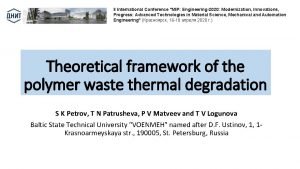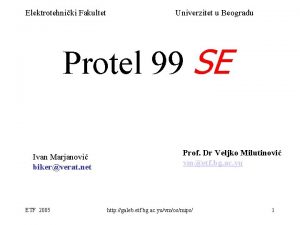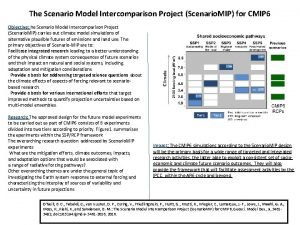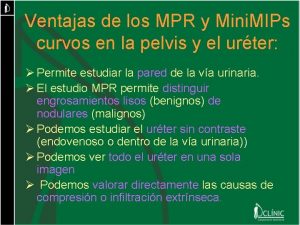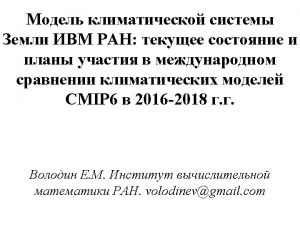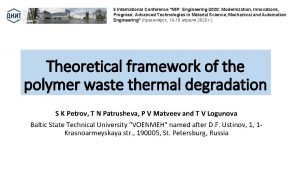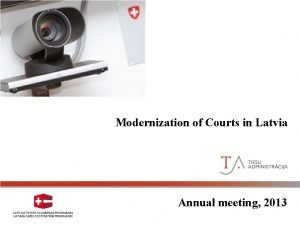II International Conference MIP Engineering2020 Modernization Innovations Progress













- Slides: 13

II International Conference "MIP: Engineering-2020: Modernization, Innovations, Progress: Advanced Technologies in Material Science, Mechanical and Automation Engineering" (Красноярск, 16 -18 апреля 2020 г. ) Theoretical framework of the polymer waste thermal degradation S K Petrov, T N Patrusheva, P V Matveev and T V Logunova Baltic State Technical University "VOENMEH" named after D. F. Ustinov, 1, 1 Krasnoarmeyskaya str. , 190005, St. Petersburg, Russia

Relevance of plastic waste disposal Currently, the production of plastic products has reached enormous proportions - in total, over 220 million tons are produced annually. Recycling plastics has become a worldwide problem. Plastic waste not only litter the environment, but also pollute it. Plastic decomposes for hundreds of years, introducing a lot of harmful substances into the soil and the aquatic environment. And when it is burned, even in special expensive furnaces, an even greater amount of harmful substances is released into the atmosphere.

Green technology for recycling plastic waste A new paradigm and a new version of the sustainable development strategy - “green” is developed In the XXI century. Green or sustainable chemical technology is based on • research results; • innovative solutions in the field of processing and recycling of materials, wastewater treatment; • energy saving; • pollution control (air, water); • the development of renewable energy sources. The focus is on technological approaches to prevent pollution. The use of pyrolytic technologies for the disposal of plastic waste can be attributed to green technologies.

Types of Plastic Waste The process for recycling plastic waste depends on the type of material that needs to be recycled. There about 150 types of plastics. 30% of them are mixtures of various polymers. For the manufacture of packaging using polypropylene (PP), polyethylene (PE), polyethylene terephthalate (PET), polyvinyl chloride (PVC), polystyrene (PS), polyamide (PA), etc. Disposable dishes are made from PE, PP (Kaplen 01030), PS (PSM 151, PSM 115), ABS plastics. In connection with the constant modernization of the plastics properties with respect to physicochemical and biological factors, the number of polymersb types is constantly increasing. The development and addition of polymeric materials with various compounds adversely affects the process of MSW processing.

Pyrolysis as a promising direction for the processing of plastic waste Pyrolysis is one of the most promising areas of MSW processing in terms of both environmental safety and the production of useful commercial products. Globally, MSW recycling is a profitable business. This is due to the fact that more developed countries have learned how to recycle household waste, to make it a valuable resource for receiving heat and different substances. However, in Russia, new waste management technologies are practically not used, and household garbage, in the best case, is simply incinerated, and in the worst, it is accumulated in landfills

Benefits of Pyrolytic Recycling The conversion of plastic waste from solid municipal waste (MSW) into fuel by pyrolyzing long-chain hydrocarbon fragments into short-chain ones has several advantages: 1. Activates a new cycle of consumption of non-renewable energy sources; 2. Provides a significant source of petrochemicals, which reduces the consumption of non-renewable energy resources; 3. It is an effective innovative alternative solution for waste elimination, preventing pollution of the environment or products of their burning, or replenishment of landfills polluting both the atmosphere and the aquatic environment.

The thermal decomposition products of plastics • The thermal degradation products of plastics are: • pyrolytic gas (is the fuel for the operation of the plants); • coke residue of 4 -5 hazard class (included in mixtures used in construction and reclamation); • synthetic oil (on its basis it is possible to obtain diesel fuel and a gasoline component); • heat generated during the pyrolysis process (supplied to space heating). The main components of pyrolytic gas are hydrogen, carbon monoxide, methane, which are used as raw materials for the synthesis of methanol, ammonia, oxoalcohols or other chemicals, as well as fuel

Thermal destruction of polymers • During thermal degradation, the destruction of the least strong bonds of the polymer substrate occurs first of all. Next, almost complete decomposition of the remaining bonds occurs while maintaining a higher temperature. A decrease in the mass of polymer raw materials is also observed in connection with depolymerization reactions, as well as static rupture of macromolecules and elimination of side groups • The reaction kinetics for various plastics followed the trend of PVP> PNP> PP over the entire temperature range. This can be explained on the basis of the C – C bond strength and polymer chain orientation in various plastics.

Low temperature and high temperature pyrolysis Depending on the decomposition temperature of organic compounds, low-temperature and high-temperature pyrolysis are distinguished. As a result of low-temperature pyrolysis carried out at a temperature of 450– 900 ° С, the resulting pyrolysis gas is minimized with a maximum yield of liquid products and a significant amount of solid residues. While maintaining the pyrolysis temperature of more than 900 ° C, which is a high-temperature pyrolysis, the maximum gas yield is in contrast to the minimum yield of solid residues and liquid product.

The dependence of the heating rate on the output of pyrolysis products • The higher the heating rate of the reactor of the pyrolyser, the greater the yield of gaseous products and the lower the mass of coke. The dependence is presented in table 1. The process is also affected by the particle size of the raw materials used. The increase in the size of the used particles of raw materials contributes to an increase in the amount of solid residue, a decrease in the proportion of pyrolytic gas and liquid products by reducing the heating rate of raw materials

The influence of other factors on the yield of pyrolysis products • An important role in the process is played by the gaseous medium in the pyrolysis chamber. It can be inert, with partial access of air, the atmosphere of hydrogen, methane, carbon dioxide, water vapor. If oxygen is present in the medium, the fraction of gaseous products contains CO and CO 2, and oxygen-containing compounds, which adversely affect the quality of gaseous fuels and oils, will be another pyrolysis product. • The pressure maintained in the pyrolysis reactor is also of great importance to the products obtained. So, when using low pressure, primary products are formed to a greater extent. If the installation operates at high pressure, the result of the process is the yield of mainly liquid products.

Influence factor The chemical composition of polymers The main factors affecting the distribution of products of polymer waste pyrolysis. Effect The primary pyrolysis products are directly related to the chemical structure of the polymers, as well as to the mechanism their thermal degradation (thermal or catalytic) Pyrolysis temperature and heating rate High process temperatures and heating rates contribute to bond breaking and predominant formation of low molecular weight products Pyrolysis time A long residence time contributes to the secondary conversion of primary products, an increase in the yield of coke, tar, as well as temperature-resistant products, thus gradually hiding the effect of the original polymer structures Type of reactor It mainly determines the quality of heat transfer (heat transfer), mixing, retention time of liquid and gaseous phases, the formation of primary products Operating pressure Low pressure reduces the condensation of active fragments forming coke and high molecular weight products The presence of active gases such as oxygen or hydrogen The formation of heat, the dilution of products. Effect on balance, kinetics and mechanism The use of catalysts It affects the kinetics and mechanism and, therefore, the distribution of pyrolysis products Additives Usually evaporate or collapse. Some may affect kinetics or mechanism. Liquid or gaseous phase The liquid phase of pyrolysis delays the output of developing products, thereby increasing the internal interaction

Conclusion • Based on the foregoing, it follows that the pyrolytic decomposition of MSW is a developing and requiring attention method due to its effectiveness and the use of recycled materials. The process itself is virtually waste-free, and thermal decomposition products can serve as raw materials for subsequent production or processing. The work was performed within the framework of the Program "Research and Development for the Priority Areas of the Russian Science-and-Technology Sector for the period of 2014– 2020"; Grant Agreement No. 05. 607. 21. 0307, the Project Unique Identifier RFMEFI 60719 X 0307.
